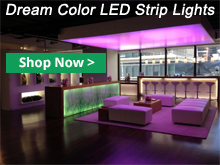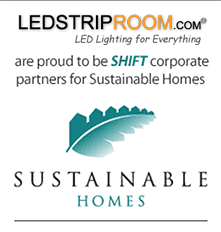Why buy LED Bulbs?

1.Why Buy from LEDStripRoom.com ?
LedStripRoom.com prides itself on quality; we guarantee our bulbs and have 24months warranty, any quality problem, free replacement is shipped.
We only use the best component parts in all our lighting solutions, working with factories that are all ROHS and CE approved. We have high quality controls in place all bulbs are age tested and go through at least 2 quality checks before they are released.
There are many bulbs on the market that do not meet these standards but we guarantee all bulbs sold by LEDStripRoom.com are made to last the long life an Led bulb should do.
2.What is an LED?
A Light Emitting Diode (LED) is a device consisting of a semiconductor that emits light energy when an electrical current is passed through it. LEDs can be used for a wide range of lighting applications. It is predicted that LED lights are the future for energy-efficient home lighting.
3.How long do LED bulbs last?
LED light bulbs have a much longer life span compared to standard halogen bulbs. In fact LED bulbs last up to 50000 hours – that’s over 5 years of continuous operation! When you install new LED lights you may never have to replace the bulbs again.
4.Do LED light bulbs provide high quality lighting?
The short answer is YES! We pride ourselves on the quality and the light output of all our bulbs simply choose between warm or cool white. You certainly won't be disappointed with the quality of the lighting!
5.Why do I need an LED-compatible transformer?
You may only need a transformer if you are buying 12v bulbs all 240 bulbs do not require a transformer, 12v bulbs are MR16, G4 and MR11.
Standard electronic transformers can cause certain types of LED bulbs to flicker, resulting in permanent long-term damage to the LED bulb itself. This problem is most evident in 12V MR16 LED bulbs where a standard transformer does not provide a smooth flow of current, causing flickering problems. To avoid damaging your new LED bulbs it is always best to use LED drivers/transformers.
6.Are LED lights cost-effective?
LED light bulbs are highly energy efficient, resulting is significant electricity savings over the life of the bulb. Electricity costs are on the increase. The average household lighting bill in the UK is around £300 per year. Replace your existing halogen bulbs with LED bulbs and you can cut your lighting costs by up to 90%. That’s an average saving of over £270 per year!
7.Can LED light bulbs be used with dimmers?
Yes. Certain types of LED bulbs are dimmable, For standard household dimmers you need a trailing edge or low voltage LED dimmer switch.
8.What are the best features of LED lights?
In short, LED lights are the future of household and office lighting, with a number of great features, including:
Extremely energy efficient
Eco-friendly lighting
Significant savings on your electricity bills
Much longer life-span than halogen bulbs
Low temperature operation
Directional light
Low profile and compact size
Breakage and vibration resistance
Life unaffected by rapid cycling
Instant switch on with no warm up time
No IR or UV emissions
9.My dimmer switch isn’t working with my LED lights?
This may be due to a couple of reasons:
Your LED bulbs may not be dimmable. Not all LED light bulbs have the ability to dim so you must make sure that your bulbs are the dimmable type.
Ensure that you have an LED-compatible dimmer switch. Standard household dimmer switches do not work with LED bulbs. Dimmable LED bulbs will only operate effectively with an LED dimmer switch.
10.What are SMDs?
SMDs or Surface Mounted Diodes are the new generation of LED lighting. The majority of our bulbs contain SMDs that are three times brighter than the older LEDs and available in warm white and cool white. LED bulbs with SMDs generate a high quality light the same colour as normal household bulbs.
11.What are the benefits of using LED lights?
LED light bulbs have many benefits when compared to standard halogen or incandescent bulbs, including:
Extremely energy efficient – 80% of electricity used converted to light energy
The most eco-friendly lighting solution
Huge reductions on your electricity bills
Much longer life-span than halogen bulbs
Low temperature operation
Directional light
Low profile and compact size
Breakage and vibration resistance
Life unaffected by rapid cycling
Instant switch on with no warm up time
No IR or UV emissions
12.My LED bulb will not switch on?
This could be due to a number of different reasons. In order to ascertain whether or not you have received a faulty bulb:
Please ensure that the bulb is receiving power from a switch/dimmer
Please check the bulb is securely in the fitting
Please place the bulb in an alternative fitting on the same circuit
13.Will LED bulbs fit into my old light fixtures?
Yes. all our bulbs are designed to be perfect fit to replace your old halogens unless it is other wise staed in the product description.
14.Do I need to replace my fittings to use LED bulbs?
No. The majority of our LED bulbs are designed to be retrofit. This means that LED light bulbs are made to fit in existing light fittings, Check our product information details on your chosen bulb before you buy.
15.Which colour is best for indoor use?
The colour choice is down to personal preference. The most popular colour for indoor LED lights is Warm White as it is the closest to the colour given off by traditional halogen spotlights. Our LED bulbs generate a high quality light the same colour as normal household bulbs.
16.Which colour is best for outdoor use?
The colour choice is down to personal preference. The most popular colour for indoor LED lights is Cool White as it gives a crisp bright light that is perfect for lighting up outdoor spaces.
17.Can I use LEDs on a 12-volt circuit?
Yes.
18.Which is better for LED lights, low voltage circuit or mains circuit?
They are both just as good.
19.How can I save the most money on my electricity bill?
The best way to maximise the savings on your electricity bill is to fit LED lights throughout your home and/or business premises. Replacing traditional forms of halogen and incandescent lighting with LED bulbs can cut lighting bills by up to 90%.
20.Why do I need to replace my dimmer switch?
The minimum wattage figure on the dimmer switch is too high, typically the majority of leading edge dimmer switches are 60 watts which is way too high for operation with dimmable LED bulbs. This is why you need an LED compatible dimmer switch for use with dimmable LED bulbs.
21.What fittings should I have for my bathroom?
Any fittings being placed within a bathroom/wet room/shower room should not only be Fire Rated but also be waterproof and hold a suitable certification of IP65 or higher in order to be compliant with relevant building regulations for bathrooms.
22.What does IP65 mean?
The IP, or Ingress Protection rating of an electrical product is a guide that is used to detail the strength of the enclosure that surrounds the electrical components.
In the case of LED lights bulbs, the IP-rating measures the tolerance to the effect of dust particles and the level of protection against water or liquids. IP65 means that the LED bulb is totally protected against dust and can withstand low-pressure jets of water from all directions – with limited ingress acceptable.
23.What does IP67 mean?
The IP, or Ingress Protection rating of an electrical product is a guide that is used to detail the strength of the enclosure that surrounds the electrical components.
In the case of LED lights bulbs, the IP-rating measures the tolerance to the effect of dust particles and the level of protection against water or liquids. IP67 means that the LED bulb is totally protected against dust and is protected against the effect of immersion in water from 6-39 inches in depth.
24.Do I have to have fire-rated fittings?
Ceilings provide an important barrier that helps to prevent the spread of fire and noise between the floors of a building. Installing recessed downlights punctures this barrier and can reduce the effectiveness of this safety barrier.
Installing fire rated downlights helps to protect your premises from the effects of both fire and noise pollution and aids compliance with new building regulations governing the installation of downlights. Made from intumescent materials, fire rated downlights seal the gap between the ceiling and the fitting to offer up to 90 minutes protection against the spread of fire into the void spaces within your ceiling / loft space. Fire rated downlights are more expensive than non-fire rated downlights. However, the worst decision you can make is to buy cheaper models that look exactly the same only to find out from the electrician fitting them, that building regulations require fire rated downlights for that situation.
25.How hot does an LED bulb get?
LED bulbs run significantly cooler than other types of lighting like halogen or CFLs but they do get hot, but the heat is dissipated by metal heat sinks that take away the heat from the light source itself. Keeping them cool helps maintain the long life span of the LED bulbs.
26.Does a GU10 LED bulb give the same brightness as my old halogen bulb?
Yes. Our LED bulbs are the perfect replacement for your existing halogen spotlight bulbs.
27.Why are LED lights considered a green technology?
LED bulbs are the only truly eco-friendly lighting solution. Unlike traditional forms of lighting where the majority of the electrical energy is given off in the form of heat, LED bulbs operate at around 80% efficiency. This means that an LED bulb converts 80% of its electricity into light energy with very little given off as heat, compared to an incandescent bulb that only turns 20% of the electricity it uses into light energy.
28.What is 3528?
The Size of the SMD chips in mm. 3528 means the chip size is 3.5mm x 2.8mm
29.What is 5050?
The Size of the SMD chips in mm. 5050 means the chip size is 5mm x 5mm
30.How does ambient temperature affect the performance of LED lights?
The performance of LED lights can be adversely affected by severe changes in ambient temperature or operating the bulbs outside the recommended temperature range. LED bulbs are tested at an ambient temperature of 25 degrees Celsius, which is adequate for most domestic environments.
However, in more challenging environments, with extreme levels of hot or cold ambient conditions, there may be a decrease in light levels together with an adverse effect on the life span of the bulb. This is why there are specially designed LED lights for use in hazardous and extreme conditions.
31.How often will I have to replace LED bulbs?
LED light bulbs have a life span of over 50000 hours of continuous operation. This means if you replace your existing halogen bulbs with /new LED bulbs, you may never have to replace your light bulbs again!
32.How long is 50000 hours?
LED light bulbs have an operational life-cycle of over 50000 hours, this equates to:
5.7 years (24 hours per day)
7.4 years (18 hours per day)
11.4 years (12 hours per day)
17.1 years (8 hours per day)
33.What SMD chips are used in our LED bulbs?
LED Hut use only the best quality SMD chips in our range of led bulbs ensuring the best quality of light, the highest levels of energy efficiency and excellent levels of reliability.
34.Do LED bulbs have any toxic materials inside them?
No. LED bulbs are referred to as solid state lighting technology and do not contain any harmful materials unlike certain other types of household lighting that contain toxic substances like mercury.
35.What LED bulbs do I need?
The type of LED bulb you require depends on your existing light fittings. Our range of LED light bulbs covers a selection of the most popular lighting types such as GU10, MR16, G4, MR11 and G9 bulbs. Make sure you get the correct size of bulb that is compatible with your existing fittings, check our product information details before you buy.
36.Do LED light bulbs switch on immediately or do they have to warm up?
LED bulbs are instant on, which means the do not require any time to warm up. Also, LED bulbs do not give off any potentially harmful IR or UV emissions.
37.Does the level of light produced reduce over the lifetime of the LED bulb?
Yes. The level of illumination does decrease over the life span of an LED bulb. However due to their extremely long life cycle, this is barely noticeable.
38.What guarantee comes with our LED bulbs?
LED Strip Bright offers a 5-year warranty on all our LED bulbs.
39.Is it true that LED lights are energy efficient?
Yes. LED bulbs operate at around 80% efficiency, compared to an incandescent bulb that is only 20% efficient. This means that an LED bulb converts 80% of its electricity into light energy. LED bulbs are the only truly eco-friendly lighting solution.
40.What is a GU5 LED bulb?
A GU5 LED bulb is another name for an MR16 LED bulb.



























